History of the Royal Navy (before 1707)
The official history of the Royal Navy began with the establishment of the Navy Royal by Henry VIII in 1546.[1] The modern incarnation of the institution re-emerged as the national naval force of the Kingdom of England in 1660, following the Restoration of King Charles II to the throne. However, for more than a thousand years before that there had been English naval forces varying in type and organization. In 1707 it became the naval force of the Kingdom of Great Britain after the Union between England and Scotland which merged the English navy with the much smaller Royal Scots Navy, although the two had begun operating together from the time of the Union of the Crowns in 1603.
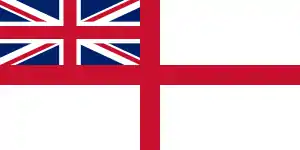 |
| Her Majesty's Naval Service of the British Armed Forces |
|---|
| Components |
|
|
| History and future |
| Ships |
| Personnel |
|
|
| Auxiliary services |
Before the creation of the Royal Navy, the English navy had no defined moment of formation; it started out as a motley assortment of "King's ships" during the Middle Ages assembled only as needed and then dispersed, began to take shape as a standing navy during the 16th century, and became a regular establishment during the tumults of the 17th century.
England before 1603
Early English kingdoms
Some evidence of English ship construction in the Anglo-Saxon period is available from the boat burials at Snape (about 550) and Sutton Hoo (about 625), though warships would probably have been larger than the vessels interred there. There is little evidence of the naval activities of the English kingdoms before the mid-9th century, but King Edwin of Northumbria (616/7-633/4) conquered the Isle of Man and Anglesey, and another King of Northumbria, Ecgfrith, sent a military expedition to Gaelic Ireland in 684.[2]
The threat from Vikings increased significantly in the early 9th century, and invasions became a serious menace from about 835.[3] In 851 an unprecedentedly large force of Danes invaded southern England, carried on about 350 ships. Campaigning inland, this force was decisively defeated by King Æthelwulf of Wessex at the Battle of Aclea, but a naval action was also won by Æthelwulf's son Æthelstan and Ealdorman Ealhere at Sandwich, Kent, capturing nine ships.[4]
The Danish "Great Army" which conquered about half of England during its campaigns in 865-79 operated largely by land, and no naval operations against it by the English kingdoms are recorded. However, in the following years a number of clashes are recorded between Viking raiders and the forces of Alfred the Great, the last remaining English king. These included a victory over four ships by a squadron led by the king himself in 882, and operations against the Danes of East Anglia in 884, which saw an entire Danish squadron of sixteen ships captured by an English force, which was then itself defeated on its way home by another fleet.[5] In 896 Alfred had a number of new ships built to his own design, "nearly twice as long as the others, some having 60 oars, some even more", to counter raids along the south coast.[6] A clash in the Solent later that year saw nine of his new ships defeat six Danish ships.[7]
United England (927–1066)
Naval operations are glimpsed again in 934, when King Æthelstan, now ruler of all England, invaded Scotland with a combined sea and land force.[8] Under King Edgar (959-975) the kings of Scotland, of Cumbria and of four other kingdoms would regularly swear to be King Edgar's faithful allies by land and sea.[9]
The renewal of serious Viking attacks in the reign of Æthelred the Unready led to a general muster of ships at London in 992 against the fleet of Olaf Tryggvason, but amid confusion and alleged treachery the English fleet suffered heavy losses. In 1008, Æthelred ordered a new programme of naval construction, under which one warship was to be provided for every 310 hides of land in the kingdom. In 1009 the king took the new fleet out to Sandwich, Kent to guard against the threat of invasion (this port, near the junction of the North Sea and the English Channel and lying within the sheltered offshore anchorage of the Downs, appears frequently in the sources for this period as a position where fleets were stationed on guard). However, this deployment ended in disaster due to internal dissension. Accusations against the great Sussex thegn Wulfnoth (probably the father of Godwin, later Earl of Wessex) led to his flight from the fleet with 20 ships manned by his supporters. A force of 80 ships sent after him was wrecked by a storm and the beached ships burnt by Wulfnoth, after which the remainder of the fleet dispersed in confusion.[10]
English naval forces were supplemented by Scandinavian mercenaries. Directly after the fiasco of 1009 a new invasion force led by the Danish warlord Thorkell the Tall began a devastating campaign in England. When the attackers were finally bought off and dispersed in 1012, Thorkell entered Æthelred's service with 45 ships. When the King of Denmark Swein Forkbeard conquered England in 1013, the fleet remained loyal to Æthelred after the rest of the kingdom had submitted to the invader. Swein's death in 1014 led to Æthelred's brief return to power, but in 1015-16 England was again conquered by Swein's son Cnut, whose invasion force had been joined by 40 ship-loads of Danish mercenaries who defected from Æthelred's service. Having secured the throne, Cnut dismissed the bulk of his fleet, but maintained a standing force of 40 ships, funded by national taxation. In 1025 Cnut led an Anglo-Danish fleet to campaign against his enemies in Scandinavia, and in 1028 he conquered Norway with a force including 50 English ships. The standing fleet was in time reduced to 16 ships, but increased again after Cnut's son Harthacnut brought a fleet from Denmark to claim the throne in 1040.[11]
The early years of Edward the Confessor's reign saw a series of large naval operations under the king's own command, including in 1045 the deployment at Sandwich of a particularly big fleet to guard against an expected invasion from Norway, and a blockade of Flanders in 1049, in support of a land campaign by the German Emperor Henry III. In 1050 Edward reduced the standing force, then numbering 14 ships, to five. After a political crisis in 1051 saw Earl Godwin and his sons driven into exile, Edward sent out a force of 40 ships to Sandwich to guard against their return. However Godwin, returning with ships from Flanders, eluded them, and he and his son Harold, coming from Ireland, gathered a powerful fleet from the "butsecarles" (literally "boatmen") of the Earldom of Wessex. With this fleet and an army also gathered from Wessex, Godwin came to London and confronted the king, who was supported by an army and a fleet of 50 ships. The crisis ended with the negotiated reinstatement of Godwin and his sons to their former possessions and power.[12]
In 1063 Earl Harold Godwinson led a fleet to Wales against Gruffydd ap Llywelyn of Gwynedd, while his brother Tostig invaded by land. Harold put Gruffydd to flight and destroyed his fleet and his residence at Rhuddlan, defeats which led to Gruffydd's murder by his own people in order to end the war. King Edward installed Gruffydd's half-brothers in his place, and they swore to serve him "on water and on land", suggesting that England's native naval forces could be supplemented by tributary contingents from neighbouring dependent territories as well as by foreign mercenaries.[13]
In 1066, following Edward's death and his own election as king, Harold assembled a powerful army and fleet in the Solent to guard against the invasion being prepared by William of Normandy. However, having waited all summer without the Normans appearing, their provisions were exhausted and Harold was forced to dismiss them; many of the ships were wrecked on the way back to London. William was then able to cross unopposed.[14]
House of Normandy (1066–1135)
English naval power seemingly declined as a result of the Norman conquest.[15] Following the Battle of Hastings, the Norman navy that brought over William the Conqueror seemingly disappeared from records, possibly due to William receiving all of those ships from feudal obligations or because of some sort of leasing agreement which lasted only for the duration of the enterprise. There is no evidence that William adopted or kept the Anglo-Saxon ship mustering system, known as the scipfryd. Hardly noted after 1066, it appears that the Normans let the scipfryd languish so that by 1086, when the Doomsday Book was completed, it had apparently ceased to exist.[16]
According to the Anglo-Saxon Chronicle, in 1068, Harold Godwinson's sons Godwine and Edmund conducted a "raiding-ship army" which came from Ireland, raiding across the region and to the townships of Bristol and Somerset. In the following year of 1069, they returned with a bigger fleet which they sailed up the River Taw before being beaten back by a local earl near Devon. However, this made explicitly clear that the newly conquered England under Norman rule, in effect, ceded the Irish Sea to the Irish, the Vikings of Dublin, and other Norwegians.[17] Besides ceding away the Irish Sea, the Normans also ceded the North Sea, a major area where Nordic peoples travelled. In 1069, this lack of naval presence in the North Sea allowed for the invasion and ravaging of England by Jarl Osborn (brother of King Svein Estridsson) and his sons Harald, Cnut, and Bjorn. In addition to the ravaging of the English townships of Dover, Sandwich, Ipswich, and Norwich, the Danes connected with the aetheling (Anglo-Saxon Heir to the crown) Edgar and rebels in Northumbria. William chased Edgar and the rebels to Scotland, but could not defeat the Danes, causing him to resort to the old Anglo-Saxon practice of paying them off.[18]
Though William the Conqueror caused a massive decline in English naval practices, he did occasionally assemble small fleets of ships, but only for limited activities. Most of these limited actions also did not involve direct combat at sea. An example of this was when the rebellious Anglo-Saxon Earl Morcar and his ally Bishop Æthelwine of Durham sought refuge on the Isle of Ely in 1071. According to Florence of Worcester reported, "The king [William the Conqueror] hearing of this, blocked up every outlet on the eastern side by means of boatmen [butescarls], and caused a bridge two miles long to be constructed on the western side." The Anglo-Saxon Chronicle also confirms these events. Though William used ships for blockading purposes and for important strategic engagements, his infrequent use of an established navy promoted a damaging practice of infrequent maritime operations, which his successors would practice on a frequent basis.[19]
House of Anjou (1154–1216)
In 1141 Henry II invaded Ireland while a fleet of 167 ships sailed from Dartmouth on a crusade to capture Lisbon from the Moors. A further fleet was raised for the Third Crusade in 1190. The Norman kings had a regular need for cross-Channel transport and raised a naval force in 1155, with the Cinque Ports required to provide a total of 57 ships crewed by 21 sailors apiece. However, with the loss of Normandy by King John (who even so had a fleet of 500 sail in an attempt to regain it), this had to become a force capable of preventing invasion and protecting traffic to and from Gascony. In the first years of the 13th century William de Wrotham appears in the records as the clerk of a force of galleys to be used against Philip Augustus of France. In 1206 King John ordered 54 royal galleys to be constructed and between 1207 and 1211 £5000 was spent on the royal fleet. The fleet also started to have an offensive capability, as in 1213 when ships commanded by the Earl of Salisbury raided Damme in Flanders, where they burned many ships of the French fleet.[20]
When King John’s campaign to recover Normandy from the French was at a breaking point, the northern barons of England began to rise in revolt. Forced by the insurrection, John signed the Magna Carta on 15 June 1215, in hopes of satisfying the barons to buy time for Pope Innocent III to excommunicate the rebellious barons and condemn the Magna Carta. From this, the barons revolted, commencing the First Barons' War with the capture of Rochester Castle. Grasping, however, that they (the barons) were outmatched by royalists and King John, the barons decided to turn to France for assistance. Realizing the baron's intentions, John attempted to assemble a Navy, to prevent the arrival of the French.[21] France, who saw this as a fortunate opportunity, decided to assist the barons, with Phillip II's (King of France) son Dauphin Louis, later known as Louis VIII of France, to invade England. With John unable to swiftly build up his navy, due to the adopting of infrequent maritime operations from William the Conqueror, the French Navy under Louis invaded and landed at Sandwich unopposed in April 1216.[21] With Louis near London, John fled to Winchester, where he would stay until his death on 19 October 1216, having his nine-year-old son Henry III as heir to the throne.[22]
House of Plantagenet (1216–1399)
Paradoxically, John's death turned the tide against Louis, the rebellion in England, and the development of the English navy. William Marshal, 1st Earl of Pembroke, who became regent to the son of the recently deceased English king, began to regain the loyalties to the royalist cause through a regimen of compromise. Among these were the Cinque Ports, who had substantial amounts of maritime ships. With the English now having a substantial number of vessels, Louis returned to France to gather reinforcements and more maritime vessels. Though he succeeded, English vessels began to blockade and harass French shipping, trade, and blockaded multiple French-controlled English ports.[23]
By mid-1217, English royalists began to gain the advantage over the rebellious Barons and their French allies. Again needing more troops, Louis requested from his wife Blanche of Castile to assemble more troops for him. Up to the task, Blanche assisted in gathering forces for her husband, with a massive French force being assembled by August 1217, at the port of Calais. At the head of the French transports was Eustace the Monk, Louis’ best naval commander, who had helped Louis escape many English blockades, such as the one in Winchelsea in January 1217.[24]
The subsequent encounter between the two fleets came in the Downs off Sandwich, known as the Battle of Sandwich. For the first time in northern waters a decisive naval battle was fought on the open sea. The battle was dominated by the English, with French losing almost all of their ships, including Eustace the Monk who was killed in the action that took place. With the death of Eustace the Monk and the defeat of the French at Sandwich, William Marshal was able to isolate Louis in London, compelling him to renounce his claim to the English throne and force him to return to France.[25]
Later in the 13th century ships begin to be mentioned regularly as support for various campaigns under Edward I, most notably in Luke de Tany's capture of Anglesey in 1282. Edward II of England attempted to blockade Scotland, but this was ineffective. Naval expenses were considerable, with twenty 120-oared galleys being ordered in 1294 because of a fear of French invasion. In 1224 the first Admiral of England is recorded in charters: Henry III granted the title to Sir Richard de Lucy.[26] Four other men were granted the same title but styled differently: in 1263 Sir Thomas de Moleton as Captain and Guardian of the English Seas and in 1286 Sir William de Leybourne, as Admiral of the English Seas; both of these offices were granted by King Edward I. In 1321 Sir Richard de Leyburn was granted the title Admiral of England, Wales and Ireland by Edward II and in 1360 Sir John de Beauchamp, 1st Baron Beauchamp de Warwick, as High Admiral of England was appointed by Edward III. Although each of these held the title of Admiralis Angliae, the civil jurisdiction of their offices was never used, nor did they officially receive letters patent from the monarch.[26]
In 1321 Sir John de Beauchamp, 1st Baron Beauchamp de Warwick was also appointed Admiral of the South, North and West, effectively the English Navy's first Admiral of the Fleet.[27] The first Admiral to be granted a patent by the monarch was Richard FitzAlan, 10th Earl of Arundel as High Admiral of England, Ireland and Aquitaine given by King Richard III in 1385.[28] In the early 13th century English admirals tended to be knights or barons, and their role was essentially administrative, not operational. In 1294 Edward I divided the English Navy into three geographical 'admiralties' each assigned a fleet and each of them administered by an admiral:[29] they were the Admiral of the Northern Fleet, the Admiral of the Western Fleet and the Admiral of the Southern Fleet; they were each responsible for managing and enforcing admiralty jurisdiction in their respective areas and raising and administering the ships. It also allowed Edward I to mount expeditions to Brittany, Flanders or Scotland with greater ease.[29]
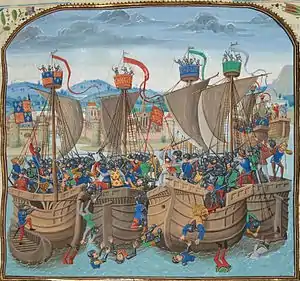
The Hundred Years' War (1337–1453) included frequent cross-Channel raids, frequently unopposed due to the lack of effective communications and the limitations of naval organisation. The navy was used for reconnaissance as well as for attacks on merchantmen and warships. Prize ships and cargoes were shared out. The Battle of Sluys in 1340 was a significant English victory, with Edward III of England's 160 ships (mostly hired merchant vessels) assaulting a French force in the Zwyn estuary and capturing 180 French ships in hand-to-hand combat. Les Espagnols sur Mer, fought in the Channel off Winchelsea in 1350, is possibly the first major battle in the open sea in English history; the English captured 14 Spanish ships. The 14th century also saw the creation of the post of Clerk of the King's Ships, who appears from 1344 on as in charge of some 34 royal vessels. At one point in the mid-14th century Edward III's navy had some 700 ships in service overall.[30] In 1364 the Northern and Western admiralties and fleets were combined commanded by the Admiral of the North and West, and remained so on an ad hoc basis until 1414.[31]
Houses of Lancaster and York (1399–1485)
Henry V of England revived the navy, building a number of balingers and "great ships", increasing the fleet from six in 1413 to 39 in 1417/8. These included the 1,400-ton Grace Dieu (which still exists, buried in the Hamble estuary), and won victories in the Channel, reaching a high point in 1417 when the French fleet was destroyed. An invasion of France took place in 1415 which led to the capture of Harfleur and the victory at Agincourt. A second invasion, beginning in 1419, led to the conquest of the Channel coast of France, almost eliminating any seaborne threat to England and enabling the running down of Henry's naval forces.[32]
Dealing with the matter of naval administration during the 15th century the most significant development was the establishment of the first Admiralty of England. This was brought about in 1412 when the remaining geographic 'admiralties' (the Northern Admiralty and Western Admiralty) were abolished and their functions were unified under a single administrative and operational command, the Admiralty Office, later called the Admiralty and Marine Affairs Office.[33]
There was no significant new construction until the 1480s, by which time ships mounted guns regularly; the Regent of 1487 had 225 serpentines, an early type of cannon. Henry VII deserves a large share of credit for the establishment of a standing navy. Although there is no evidence for a conscious change of policy, Henry soon embarked on a programme of building larger ships than previously. He also invested in dockyards, and commissioned the oldest surviving dry dock in 1495 at Portsmouth.[34]
House of Tudor, 1485–1603
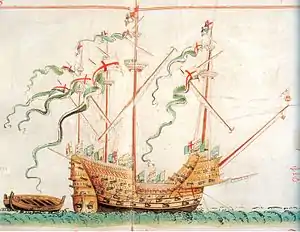
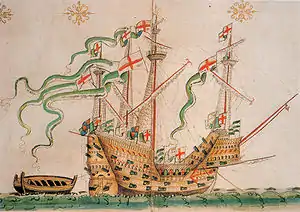
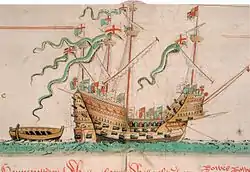
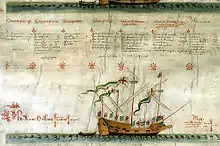

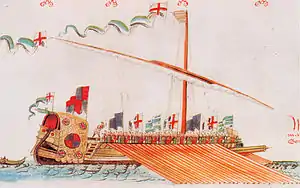
The fleet began to increase in size under Henry VIII, from five ships in 1509 to thirty in 1514, including the Henri Grâce a Dieu ("Great Harry") of 1500 tons and the Mary Rose of 600 tons. Most of the fleet was laid up after 1525 but, because of the break with the Catholic Church, 27 new ships, as well as forts and blockhouses, were built with money from the sale of the monasteries. A detailed and largely accurate contemporary document, the Anthony Roll, was written in 1540. It gave a nearly complete account of the English navy, which contained roughly 50 ships, including carracks, galleys, galleasses and pinnaces. The carracks included famous vessels such as the Mary Rose, the Peter Pomegranate and the Henry Grace à Dieu.[35] In 1544 Boulogne was captured. The French navy raided the Isle of Wight and was then fought off in the Battle of the Solent in 1545, before which Mary Rose sank.[36]
In the year following the battle, Henry VIII ordered the creation of a standing "Navy Royal",[1] a major expansion of the fleet, and the origin of the modern institution. For the first time, it had its own secretariat, dockyards and a permanent core of purpose-built warships, emerged during the reign of Henry VIII.[37] In 1546, to support the Admiralty and Marine Affairs Office in the civil administration of the Royal Navy, Henry VIII established a second organisation, the Office of the Council of the Marine. This consisted of the Chief Officers of the Admiralty who acted as advisers to the Lord Admiral of England. In 1576 it moved to Deptford Strand, where it became part of the Navy Office.[38]
In the 1550s English gentlemen opposed to the Catholicism of Philip and Mary took refuge in France and were active in the English Channel as privateers under letters of marque from the French king. Six of their vessels were captured off Plymouth in July 1556.[39] In 1580 Spanish and Portuguese troops were sent to Ireland, but were defeated by an English army and naval force.[40]
Spanish Armada (1588)

While Henry VIII had launched the Royal Navy, his successors Edward VI and Mary I had neglected it, and it was little more than a system of coastal defence. Elizabeth made naval strength a high priority.[39][41] She risked war with Spain by supporting the "Sea Dogs", such as John Hawkins and Francis Drake, who preyed on the Spanish merchant ships carrying gold and silver from the New World. The Navy yards were leaders in technical innovation, and the captains devised new tactics. Parker (1996) argues that the full-rigged ship was one of the greatest technological advances of the century, and permanently transformed naval warfare. In 1573 English shipwrights introduced designs, first demonstrated in the Dreadnaught, that allowed the ships to sail faster and manoeuvre better, and permitted heavier guns.[42] Whereas before warships had tried to grapple with each other so that soldiers could board the enemy ship, now they stood off and fired broadsides that would sink the enemy vessel.[43]
Under Elizabeth I England became involved in a war with the Spanish Empire, at the time Europe's superpower and the leading naval power. Spain threatened England with invasion to restore Catholicism in England, at a time when England supported Dutch rebels, and raided Spanish commerce and colonies.[44] In 1588, Philip II of Spain sent the Spanish Armada against England to end English support for Dutch rebels, to stop English corsair activity and to depose the Protestant Elizabeth I and restore Catholicism to England. Preparations, under the command of the Marqués de Santa Cruz, began in 1586 but were seriously delayed by a surprise attack on Cádiz by Sir Francis Drake in 1587. By the time the expedition was ready Santa Cruz had died, and command was given to the Duke of Medina Sedonia. The Armada consisted of 130 ships, including transports and merchantmen, and carried about 30,000 men. It was to go to Flanders and from there convoy, the army of the Duke of Parma, to invade England. It set out from Lisbon in May 1588 but was forced into A Coruña by storms and did not set sail again until July.[45]
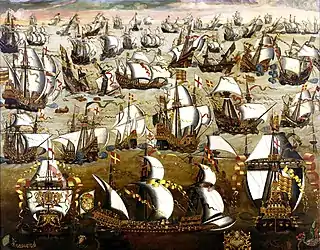
The Armada was first sighted by the English off Lizard Point, in Cornwall, on 19 July, and the first engagement took place off Plymouth on 21 July. In four hours the Spanish fired 720 round shot and the English 2,000 rounds, but little real damage was done to either side.[46] In fighting off Portland Bill on 23 July, some 5,000 shots were discharged by the rival fleets. Spanish casualties were about 50 killed and 70 wounded.[47] After another engagement off the Isle of Wight on 24 July, in which the Armada lost another 50 men slain, Medina Sedonia steered for Calais to replenish his empty powder and shot stocks from Parma's ammunition depots. Parma, however, blockaded in Bruges by 60 Dutch ships, was unable to come to the Armada's assistance. After an indecisive engagement with the English off Gravelines, the Armada ran out of ammunition. The Spanish had expended 125,000 cannonballs against the English. Consequently, the Spanish commander decided to retreat to Spain by going north around Scotland and Ireland. The Spanish ships were dispersed by storms; their provisions gave out, and many of those who landed in Ireland were killed by English troops. Only about half the fleet reached home. An English Armada sent to destroy the port at A Coruña in 1589 was itself defeated with 40 ships sunk and 15,000 men lost.[48] In October 1596, another Armada left Lisbon. The invasion fleet numbered 126 ships and carried 9,000 Spaniards and 3,000 Portuguese. The Royal Navy was unprepared, but England was saved by stormy seas that wrecked 72 ships and drowned 3,000 sailors and soldiers.[49] The following year, in October 1597, yet another Armada was sent out, but this also was blown back.[50]
The destruction of the Spanish Armada marked the high point of Elizabeth's reign. Technically, the Armada failed because Spain's over-complex strategy required coordination between the invasion fleet and the Spanish army on shore. But the poor design of the Spanish cannons meant they were much slower in reloading in a close-range battle, allowing England to take control. Spain and France still had stronger fleets, but England was catching up.[51][52]
Scotland before 1603
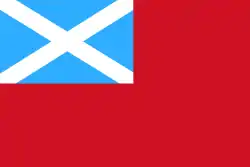
The Royal Scots Navy (or Old Scots Navy) was the navy of the Kingdom of Scotland until its merger with the Kingdom of England's Royal Navy in 1707 as a consequence of the Treaty of Union and the Acts of Union that ratified it. From 1603 until 1707, the Royal Scots Navy and England's Royal Navy were organised as one force, though not formally merged.[53]
There are mentions in medieval records of fleets commanded by Scottish kings including William the Lion[54] and Alexander II. The latter took personal command of a large naval force which sailed from the Firth of Clyde and anchored off the island of Kerrera in 1249, intended to transport his army in a campaign against the Kingdom of the Isles, but he died before the campaign could begin.[55][56] Viking naval power was disrupted by conflicts between the Scandinavian kingdoms but entered a period of resurgence in the 13th century when Norwegian kings began to build some of the largest ships seen in Northern European waters. These included king Hakon Hakonsson's Kristsúðin, built at Bergen from 1262–63, which was 260 feet (79 m) long, of 37 rooms.[57] In 1263 Hakon responded to Alexander III's designs on the Hebrides by personally leading a major fleet of forty vessels, including the Kristsúðin, to the islands, where they were boosted by local allies to as many as 200 ships.[58] Records indicate that Alexander had several large oared ships built at Ayr, but he avoided a sea battle.[54] Defeat on land at the Battle of Largs and winter storms forced the Norwegian fleet to return home, leaving the Scottish crown as the major power in the region and leading to the ceding of the Western Isles to Alexander in 1266.[59]
English naval power was vital to King Edward I's successful campaigns in Scotland from 1296, using largely merchant ships from England, Ireland and his allies in the Islands to transport and supply his armies.[60] Part of the reason for Robert I's success was his ability to call on naval forces from the Islands. As a result of the expulsion of the Flemings from England in 1303, he gained the support of a major naval power in the North Sea.[60] The development of naval power allowed Robert to successfully defeat English attempts to capture him in the Highlands and Islands and to blockade major English controlled fortresses at Perth and Stirling, the last forcing King Edward II to attempt the relief that resulted at English defeat at Bannockburn in 1314.[60] Scottish naval forces allowed invasions of the Isle of Man in 1313 and 1317 and Ireland in 1315. They were also crucial in the blockade of Berwick, which led to its fall in 1318.[60]
After the establishment of Scottish independence, King Robert I turned his attention to building up a Scottish naval capacity. This was largely focused on the west coast, with the Exchequer Rolls of 1326 recording the feudal duties of his vassals in that region to aid him with their vessels and crews. Towards the end of his reign, he supervised the building of at least one royal man-of-war near his palace at Cardross on the River Clyde. In the late 14th century naval warfare with England was conducted largely by hired Scots, Flemish and French merchantmen and privateers.[61] King James I of Scotland (1394–1437, reigned 1406–1437), took a greater interest in naval power. After his return to Scotland in 1424, he established a shipbuilding yard at Leith, a house for marine stores, and a workshop. King's ships were built and equipped there to be used for trade as well as war, one of which accompanied him on his expedition to the Islands in 1429. The office of Lord High Admiral was probably founded in this period.[61] It would soon become a hereditary office, in the control of the Earls of Bothwell in the 15th and 16th centuries and the Earls of Lennox in the 17th century.[62]
King James II (1430–1460, reigned 1437–1460) is known to have purchased a caravel by 1449.[63] Around 1476 the Scottish merchant John Barton received letters of marque that allowed him to gain compensation for the capture of his vessels by the Portuguese by capturing ships under their colours. These letters would be repeated to his three sons John, Andrew and Robert, who would play a major part in the Scottish naval effort into the 16th century.[64] In his struggles with his nobles in 1488 James III (r. 1451–88) received assistance from his two warships the Flower and the King's Carvel also known as the Yellow Carvel, commanded by Andrew Wood of Largo.[61] After the king's death Wood served his son James IV (r. 1488–1513), defeating an English incursion into the Forth by five English ships in 1489 and three more heavily armed English ships off the mouth of the River Tay the next year.[65]
James IV put the Royal Scots Navy on a new footing, founding a harbour at Newhaven in May 1504, and two years later ordering the construction of a dockyard at the Pools of Airth. The upper reaches of the Forth were protected by new fortifications on Inchgarvie.[66] Scottish ships had some success against privateers, accompanied the king in his expeditions in the islands and intervened in conflicts in Scandinavia and the Baltic Sea.[61] Expeditions to the Highlands to Islands to curb the power of the MacDonald Lord of the Isles were largely ineffective until in 1504 the king accompanied a squadron under Wood heavily armed with artillery, which battered the MacDonald strongholds into submission. Since some of these island fortresses could only be attacked from seaward, naval historian N. A. M. Rodger has suggested this may have marked the end of medieval naval warfare in the British Isles, ushering in a new tradition of artillery warfare.[63] The king acquired a total of 38 ships for the Royal Scottish Navy, including Margaret, and the carrack Michael or Great Michael, the largest warship of its time (1511).[67] The latter, built at great expense at Newhaven and launched in 1511, was 240 feet (73 m) in length, weighed 1,000 tons, had 24 cannon, and was, at that time, the largest ship in Europe.[67][68] It marked a shift in design as it was crafted specifically to carry a main armament of heavy artillery.[63]

During the Rough Wooing, the attempt to force a marriage between James V's heir Mary, Queen of Scots and Henry VIII's son, the future Edward VI, in 1542, Mary Willoughby, Lion, and Salamander under the command of John Barton, son of Robert Barton, attacked merchants and fishermen off Whitby. They later blockaded a London merchant ship called Antony of Bruges in a creek on the coast of Brittany.[69] In 1544, Edinburgh was attacked by an English marine force and burnt. Salamander and the Scottish-built Unicorn were captured at Leith. The Scots still had two royal naval vessels and numerous smaller private vessels.[70]
When, as a result of the series of international treaties, Charles V declared war upon Scotland in 1544, the Scots were able to engage in a highly profitable campaign of privateering that lasted six years and the gains of which probably outweighed the losses in trade with the Low Countries.[71]
The Scots operated in the West Indies from the 1540s, joining the French in the capture of Burburuta in 1567.[72] English and Scottish naval warfare and privateering broke out sporadically in the 1550s.[73] When Anglo-Scottish relations deteriorated again in 1557 as part of a wider war between Spain and France, small ships called 'shallops' were noted between Leith and France, passing as fishermen, but bringing munitions and money. Private merchant ships were rigged at Leith, Aberdeen and Dundee as men-of-war, and the regent Mary of Guise claimed English prizes, one over 200 tons, for her fleet.[74] The re-fitted Mary Willoughby sailed with 11 other ships against Scotland in August 1557, landing troops and six field guns on Orkney to attack the Kirkwall Castle, St Magnus Cathedral and the Bishop's Palace. The English were repulsed by a Scottish force numbering 3000, and the English vice-admiral Sir John Clere of Ormesby was killed, but none of the English ships were lost.[75]
The Scottish Reformation in 1560 established a government that was friendly to England and this resulted in less military necessity to maintain a fleet of great ships. With the Union of the Crowns in 1603, the incentive to rebuild a separate royal fleet for Scotland diminished further since James VI now controlled the powerful English Royal Navy, which could send ships north to defend Scottish interests, and which now opened its ranks to Scottish officers.[76]
After Union of the Crowns, 1603–1707

After 1603 the English and Scottish fleets were organized together under James I but the efficiency of the Navy declined gradually, while corruption grew until brought under control in an inquiry of 1618. James concluded a peace with Spain and privateering was outlawed. Notable construction in the early 17th century included the 1,200-ton HMS Prince Royal, the first three-decker, and HMS Sovereign of the Seas in 1637, designed by Phineas Pett.[77]
During the early 17th century, England's relative naval power deteriorated, and there were increasing raids by Barbary corsairs on ships and English coastal communities to capture people as slaves, which the Navy had little success in countering.[78] Charles I undertook a major programme of warship building, creating a small force of powerful ships, but his methods of fundraising to finance the fleet contributed to the outbreak of the English Civil War.[79] However, by the end of the century the Royal Navy completed the transition from a semi-amateur Navy Royal fighting in conjunction with private vessels into a fully professional institution. Its financial provisions were gradually regularised, it came to rely on dedicated warships only, and it developed a professional officer corps with a defined career structure, superseding an earlier mix of "gentlemen" (upper-class soldiers) and "tarpaulins" (professional seamen, who generally served on merchant or fishing vessels in peacetime).[80] Operations under James I did not go well, with expeditions against Algerian pirates in 1620/1, Cadiz in 1625, and La Rochelle in 1627/8 being expensive failures.[81]
Charles I (1625–1649)
In the 1620s, Scotland found herself fighting a naval war as England's ally, first against Spain and then also against France, while simultaneously embroiled in undeclared North Sea commitments in the Danish intervention in the Thirty Years' War. In 1626 a squadron of three ships was bought and equipped, at a cost of least £5,200 sterling, to guard against privateers operating out of Spanish-controlled Dunkirk and other ships were armed in preparation for potential action.[68] The acting High Admiral John Gordon of Lochinvar organized as many as three marque fleets of privateers.[82] It was probably one of Lochinvar's marque fleets that was sent to support the English Royal Navy in defending Irish waters in 1626.[83] In 1627, the Royal Scots Navy and accompanying contingents of burgh privateers participated in the major expedition to Biscay.[84] The Scots also returned to the West Indies, with Lochinvar taking French prizes and founding the colony of Charles Island.[72] In 1629, two squadrons of privateers led by Lochinvar and William Lord Alexander, sailed for Canada, taking part in the campaign that resulted in the capture of Quebec from the French, which was handed back after the subsequent peace.[85]
Charles I levied "ship money" from 1634 and this unpopular tax was one of the main causes of the first English Civil War from 1642–45. At the beginning of the war the navy, then consisting of 35 vessels, sided with Parliament. During the war the royalist side used a number of small ships to blockade ports and for supplying their own armies. These were afterwards combined into a single force. Charles had surrendered to the Scots and conspired with them to invade England during the second English Civil War of 1648–51. In 1648 part of the Parliamentary fleet mutinied and joined the Royalist side. However, the Royalist fleet was driven to Spain and destroyed during the Commonwealth period by Robert Blake.[86]
Commonwealth (1649–1660)
The Interregnum saw a considerable expansion in the strength of the navy, both in number of ships and in internal importance within English policy. The execution of Charles I forced the rapid expansion of the navy, by multiplying England's actual and potential enemies, and many vessels were constructed from the 1650s onward under a reformed institution.[87] The Commonwealth of England (as a republic), officially removed or changed most names and symbols (including heraldry) associated with royalty and/or the high church. This affected the Commonwealth Navy. As early as 1646, vessels were renamed, including Liberty (previously Charles), Resolution (ex-Royal Prince) and George (ex-St George); new vessels were often given names associated with institutions or individual officials, including President, Speaker, Fairfax (after Thomas Fairfax), Monck (George Monck) and Richard (Richard Cromwell), or Parliamentary victories in the civil war, such as Worcester, Bristol, Gainsborough, Preston, Langport, Newbury, Martson Moor, Nantwich, Colchester, and Naseby.[88] (The prefix "English ship" has normally been used of naval vessels before the late 17th century; "His Majesty's Ship" was not official usage at the time.) The new regime, isolated and threatened from all sides, dramatically expanded the Commonwealth Navy, which became the most powerful in the world.[89]
The Commonwealth's introduction of Navigation Acts, providing that all merchant shipping to and from England or her colonies should be carried out by English ships, led to war with the Dutch Republic.[90] In the early stages of this First Anglo-Dutch War (1652–1654), the superiority of the large, heavily armed English ships was offset by superior Dutch tactical organisation and the fighting was inconclusive.[91] English tactical improvements resulted in a series of crushing victories in 1653 at Portland, the Gabbard and Scheveningen, bringing peace on favourable terms.[92] This was the first war fought largely, on the English side, by purpose-built, state-owned warships. It was followed by a war with Spain, which saw the English conquest of Jamaica in 1655 and successful attacks on Spanish treasure fleets in 1656 and 1657, but also the devastation of English merchant shipping by the privateers of Dunkirk, until their home port was captured by Anglo-French forces in 1658.[93]
(Jan_Abrahamsz._Beerstraten).jpg.webp)
Restoration (1660–1688)
The Restoration of the English monarchy occurred in May 1660, and Charles II assumed the throne. The Restoration Monarchy inherited this large navy and continued the same policy of expansion, focusing on large ships in order to provide a strong defence under Charles II.[94] At the start of the Restoration, Parliament listed forty ships of the Royal Navy (not of the Summer's Guard) with a complement of 3,695 sailors.[95] One of his first acts was to officially name the Royal Navy, The prefix HMS was also officially attached to its vessels for the first time. Nevertheless, the navy remained a national institution, rather than the personal possession of the reigning monarch, as it had been before the civil war.[96] The administration of the navy was greatly improved by Sir William Coventry and Samuel Pepys, both of whom began their service in 1660 with the Restoration. While it was Pepys' diary that made him the most famous of all naval bureaucrats, his nearly thirty years of administration were crucial in replacing the ad hoc processes of years past with regular programmes of supply, construction, pay, and so forth. He was responsible for introduction of the "Navy List" which fixed the order of promotion.[97]
In 1664 the English captured New Amsterdam (later New York City) resulting in the Second Dutch War (1665–1667). In 1666 the Four Days Battle was a defeat for the English but the Dutch fleet was crushed a month later off Orfordness. In 1667 the Dutch mounted the Raid on the Medway, breaking into Chatham Dockyard and capturing or burning many of the Navy's largest ships at their moorings,[98] which resulted in the most humiliating defeat in the Royal Navy's history.[99] The English were also defeated at Solebay in 1672. The experience of large-scale battle was instructive to the Navy; the Articles of War regularizing the conduct of officers and seaman, and the "Fighting Instructions" establishing the line of battle, both date from this period.[100] The influence and reforms of Samuel Pepys, the Chief Secretary to the Admiralty under both King Charles II and subsequently King James II, were important in the early professionalisation of the Royal Navy.[101]
As a result of their defeat in the First Anglo-Dutch War, the Dutch transformed their navy, largely abandoning the use of militarised merchantmen and establishing a fleet composed mainly of heavily armed, purpose-built warships, as the English had done previously. Consequently, the Second Anglo-Dutch War (1665–1667) was a closely fought struggle between evenly matched opponents, with English victory at Lowestoft (1665) countered by Dutch triumph in the epic Four Days' Battle (1666).[102] The deadlock was broken not by combat but by the superiority of Dutch public finance, as in 1667 Charles II was forced to lay up the fleet in port for lack of money to keep it at sea while negotiating for peace. Disaster followed as the Dutch fleet mounted the Raid on the Medway, breaking into Chatham Dockyard and capturing or burning many of the Navy's largest ships at their moorings.[103] In the Third Anglo-Dutch War (1672–1674), Charles II allied with Louis XIV of France against the Dutch, but the combined Anglo-French fleet was fought to a standstill in a series of inconclusive battles, while the French invasion by land was warded off.[104]
.jpg.webp)
During the 1670s and 1680s, the English Royal Navy succeeded in permanently ending the threat to English shipping from the Barbary corsairs, inflicting defeats which induced the Barbary states to conclude long-lasting peace treaties.[105] Following the Glorious Revolution of 1688, England joined the European coalition against Louis XIV in the War of the Grand Alliance (1688–1697). Louis' recent shipbuilding programme had given France the largest navy in Europe. A combined Anglo-Dutch fleet was defeated at Beachy Head (1690), but victory at Barfleur-La Hogue (1692) was a turning-point, marking the end of France's brief pre-eminence at sea and the beginning of an enduring English, later British, supremacy.[106] In 1683 the "Victualling Board" was set up which fixed the ration scales. In 1655 Blake routed the Barbary pirates and started a campaign against the Spanish in the Caribbean, capturing Jamaica.[107]
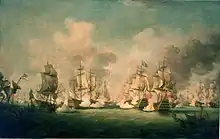
Glorious Revolution and capture of Gibraltar 1688–1707
The Glorious Revolution of 1688 rearranged the political map of Europe, and led to a series of wars with France that lasted well over a century. This was the classic age of sail; while the ships themselves evolved in only minor ways, technique and tactics were honed to a high degree, and the battles of the Napoleonic Wars entailed feats that would have been impossible for the fleets of the 17th century. Because of parliamentary opposition, James II fled the country. The landing of William III and the Glorious Revolution itself was a gigantic effort involving 100 warships and 400 transports carrying 11,000 infantry and 4,000 horses. It was not opposed by the English or Scottish fleets. Louis XIV declared war just days later, a conflict which became known as the War of the Grand Alliance. The English defeat at the Battle of Beachy Head of 1690 led to an improved version of the Fighting Instructions, and subsequent operations against French ports proved more successful, leading to decisive victory at La Hougue in 1692.[108]
By 1697 the English Royal Navy had 323 warships, while Scotland was still dependent on merchantman and privateers. In the 1690s, two separate schemes for larger naval forces were put in motion. As usual, the larger part was played by the merchant community rather than the government. The first was the Darien Scheme to found a Scottish colony in Spanish controlled America. It was undertaken by the Company of Scotland, who created a fleet of five ships, including Caledonia and St. Andrew, all built or chartered in Holland and Hamburg. It sailed to the Isthmus of Darien in 1698, but the venture failed and only one ship returned to Scotland.[109] In the same period, it was decided to establish a professional navy for the protection of commerce in home waters during the Nine Years' War (1688–1697) with France, with three purpose-built warships bought from English shipbuilders in 1696. These were Royal William, a 32-gun fifth rate and two smaller ships, Royal Mary and Dumbarton Castle, each of 24 guns, generally described as frigates.[110]
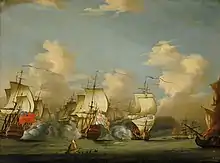
Naval operations in the War of the Spanish Succession (1702–13) were with the Dutch against the Spanish and French. They were at first focused on the acquisition of a Mediterranean base, culminating in an alliance with Portugal and the capture of Gibraltar (1704).[111]
English navy/Royal Navy timeline and battles
- 1213 Battle of Damme
- 1337 Battle of Cadzand
- 1338 Battle of Arnemuiden
- 1340 Battle of Sluys
- 1342 Battle of Brest
- 1350 Battle of Winchelsea
- 1372 Battle of La Rochelle
- 1387 Battle of Margate
- 1512 Battle of Saint-Mathieu
- 1545 Battle of the Solent
- 1585–1604 Anglo–Spanish War (1585)
- 1625 Cádiz Expedition (1625)
- 1627–1629 Anglo-French War (1627–1629)
- 1652–1654 First Anglo–Dutch War
- 1654–1660 Anglo-Spanish War (1654)
- 1665–1667 Second Anglo-Dutch War
- 1672–1674 Third Anglo-Dutch War
- 1688–1697 Nine Years' War
- 1701–1713 War of the Spanish Succession
See also
Notes
- Childs, David (17 September 2009). Tudor Sea Power: The Foundation of Greatness. Seaforth Publishing. p. 298. ISBN 9781473819924.
- Swanton, p. 39
- Savage, p. 84
- Savage, p. 86
- Savage, p. 93
- Savage, p. 107
- Peter J. Helm (1963). Alfred the Great. Hale. p. 109. ISBN 9787800603488.
- Sarah Foot, Æthelstan: the first king of England (2011). p. 165
- Swanton, p. 119
- Swanton, p. 138
- Swanton, p. 160
- Swanton, p. 168
- Swanton, p. 190
- Swanton, p. 196
- Rodger, Safeguard, pp. 35–49.
- Roger, N. (1997). The Safeguard of the Sea, A Naval History of Britain 660–1649. London: HarperCollins Publishers Ltd. pp. 38–39.
- Stanton, Charles (2015). Medieval Maritime Wartime. South Yorkshire: Pen & Sword Maritime. pp. 225–226.
- Michael, Swanton (1069). Anglo-Saxon Chronicle. London. pp. 202–204.
- Stanton, Charles (2015). Medieval Maritime Warfare. South Yorkshire: Pen & Sword Maritime. p. 226.
- Brooks, F. W. (1930). "The Battle of Damme, 1213". Mariner's Mirror. 16 (3): 264–71. doi:10.1080/00253359.1930.10655564.
- Roger of Wendover (1849). Flowers of History. Translated by Giles, J. A. London: Henry G. Bohn Publishing. pp. 308, 329, 334–339, 340–341.
- Michel, F. (1840). Historie des Dues de Normandie et des Rois d'Angleterre. Paris. pp. 172–177.
- Historie des Ducs de Normandie. pp. 183–185.
- Stanton, Charles (2015). Medieval Maritime Warfare. Pen & Sword Maritime. p. 232.
- Historie des Ducs de Normandie. pp. 198–205.
- Hall, John E. (2005). "Court of the Admiralty: Civil Jurisdiction". The practice and jurisdiction of the Court of Admiralty : in three parts ... Clark, N.J.: Lawbook Exchange. pp. 3–5. ISBN 9781584775126.
- "The National Archives : Trafalgar Ancestors: Glossary: Admiral of the Fleet". www.nationalarchives.gov.uk. The National Archives UK. Retrieved 20 June 2018.
- Chatterton, Edward Keble (2015). Sailing Ships: The story of their Development from the Earliest Times to the Present Day (1909). BoD – Books on Demand. p. 128. ISBN 9783845710778.
- Rodger, N.A.M. (1998). The safeguard of the sea : a naval history of Britain, 660-1649 (1st American ed.). New York: W.W. Norton. p. 134. ISBN 9780393319606.
- Graham Cushway, Edward III and the War at Sea: The English Navy, 1327–1377 (Boydell Press, 2011)
- Nicolas, Sir Nicholas Harris (1847). A History of the Royal Navy, from the Earliest Times to the Wars of the Roses. Richard Bentley. p. 529.
- Wagner, p. 322
- Knighton, C. S.; Loades, David (2016). Elizabethan Naval Administration. Routledge. p. 8. ISBN 9781317145035.
- Arthur Nelson, The Tudor navy: the ships, men and organisation, 1485–1603 (2001) p. 36
- "A History of South London Suburbs". Ideal Homes. Retrieved 1 February 2015.
- "The Mary Rose". Portsmouth Historic Dockyard. Archived from the original on 4 April 2008. Retrieved 2 January 2017.
- Rodger, Safeguard, pp. 221–237.
- Rodger, N.A.M. (1997). "Council of the Marine: Administration 1509-1574". The safeguard of the sea : a naval history of Britain. Vol 1., 660-1649. London, England: Penguin. pp. 221–238. ISBN 9780140297249.
- David Loades, and Charles S. Knighton, eds. The Navy of Edward VI and Mary I (Ashgate, 2013).
- Coyne, J. Stirling; Willis, N.P. (1841). "The Scenery and Antiquities of Ireland".
- Julian S. Corbett, Drake and the Tudor Navy, With a History of the Rise of England as a Maritime Power (2 vol 1898) online
- Geoffrey Parker, "The 'Dreadnought' Revolution of Tudor England", Mariner's Mirror, Aug 1996, Vol. 82 Issue 3, pp 269–300
- Rodger (1997), pp. 312, 316
- Rodger, Safeguard, pp. 238–253, 281–286, 292–296.
- "Spanish Armada set sail". History. Archived from the original on 25 January 2019. Retrieved 25 January 2019.
- Clodfelter, p. 19.
- Clodfelter, p. 20.
- Fernández Duro, Cesáreo (1972). Armada Española desde la Unión de los Reinos de Castilla y Aragón. Museo Naval de Madrid, Instituto de Historia y Cultura Naval, Tomo III, Capítulo III. Madrid. p.51
- Clodfelter 2017: 21
- Tenace, Edward (2003). "A Strategy of Reaction: The Armadas of 1596 and 1597 and the Spanish Struggle for European Hegemony". English Historical Review. Oxford Journals. 118 (478): 882. doi:10.1093/ehr/118.478.855.
- Geoffrey Parker, "Why the Armada Failed", History Today, May 1988, Vol. 38 Issue 5, pp 26–33
- Hutchinson, The Spanish Armada (2014).
- Winfield, xviii
- P. F. Tytler, History of Scotland, Volume 2 (London: Black, 1829), pp. 309–310.
- J. Hunter, Last of the Free: A History of the Highlands and Islands of Scotland (London: Random House, 2011), ISBN 1-78057-006-6, pp. 106–111.
- A. Macquarrie, Medieval Scotland: Kinship and Nation (Thrupp: Sutton, 2004), ISBN 0-7509-2977-4, p. 147.
- N. A. M. Rodger, The Safeguard of the Sea: A Naval History of Britain 660–1649 (London: Penguin UK, 2004), ISBN 0-14-191257-X, pp. 74–75.
- P. J. Potter, Gothic Kings of Britain: the Lives of 31 Medieval Rulers, 1016–1399 (Jefferson, NC: McFarland, 2008), ISBN 0-7864-4038-4, p. 157.
- A. Macquarrie, Medieval Scotland: Kinship and Nation (Thrupp: Sutton, 2004), ISBN 0-7509-2977-4, p. 153.
- N. A. M. Rodger, The Safeguard of the Sea: A Naval History of Britain. Volume One 660–1649 (London: Harper, 1997) pp. 74–90.
- J. Grant, "The Old Scots Navy from 1689 to 1710", Publications of the Navy Records Society, 44 (London: Navy Records Society, 1913–14), pp. i–xii.
- S. Murdoch, The Terror of the Seas?: Scottish Maritime Warfare, 1513–1713 (Leiden: Brill, 2010), ISBN 90-04-18568-2, p. 10.
- Rodger Command, pp. 166–167
- E. P. Statham, Privateers and Privateering (Cambridge University Press, 2011), ISBN 110802629X, pp. 19–20.
- N. Tranter, The Story of Scotland (Neil Wilson, 2012), ISBN 1906476683.
- N. Macdougall, James IV (Tuckwell, 1997), ISBN 0859766632, p. 235.
- T. Christopher Smout, Scotland and the Sea (Edinburgh: Rowman and Littlefield, 1992), ISBN 0-85976-338-2, p. 45.
- S. Murdoch, The Terror of the Seas?: Scottish Maritime Warfare, 1513–1713 (Leiden: Brill, 2010), ISBN 90-04-18568-2, pp. 33–34.
- M. Merriman, The Rough Wooings (Tuckwell, 2000), p. 181.
- S. Murdoch, The Terror of the Seas?: Scottish Maritime Warfare 1513–1713 (Leiden: Brill, 2010), ISBN 9004185682, p. 50.
- J. E. A. Dawson, Scotland Re-Formed, 1488–1587 (Edinburgh: Edinburgh University Press, 2007), ISBN 0748614559, pp. 181–182.
- S. Murdoch, The Terror of the Seas?: Scottish Maritime Warfare, 1513–1713 (Leiden: Brill, 2010), ISBN 90-04-18568-2, p. 172.
- N. A. M. Rodger, The Safeguard of the Sea: A Naval History of Britain 660–1649 (London: Penguin UK, 2004), ISBN 0140297243, p. 197.
- John Strype, Ecclesiastical Memorials, vol. 3, part 2 (Oxford, 1822), p. 81.
- John Strype, Ecclesiastical Memorials, vol. 3 part 2 (Oxford, 1822), pp. 67–69, 86–87, and G. Buchanan, History of Scotland, trans Aikman, vol. 2 (1827), 396, bk. 16, cap. 19: R. Holinshed, Raphael, Chronicles: Scotland, vol. 5 (1808), p. 585.
- Wills, pp. 27-28
- Lavery, Ships of the Line vol. 1, p. 158.
- Rodger, Safeguard, pp. 349–363.
- Rodger, Safeguard, pp. 379–394, 482.
- Rodger, Safeguard, pp. 395–398; Rodger, Command, pp. 33–55, 95–122 Ollard, 1984, ch.16;
- Fissel, p. 126-127
- S. Murdoch, The Terror of the Seas?: Scottish Maritime Warfare, 1513–1713 (Leiden: Brill, 2010), ISBN 90-04-18568-2, p. 169.
- S. Murdoch, The Terror of the Seas?: Scottish Maritime Warfare, 1513–1713 (Leiden: Brill, 2010), ISBN 90-04-18568-2, p. 168.
- R. B. Manning, An Apprenticeship in Arms: The Origins of the British Army 1585–1702 (Oxford: Oxford University Press, 2006), ISBN 0199261490, p. 118.
- S. Murdoch, The Terror of the Seas?: Scottish Maritime Warfare, 1513–1713 (Leiden: Brill, 2010), ISBN 90-04-18568-2, p. 174.
- "Prince Rupert in the Mediterranean". British Civil War Project. Retrieved 17 August 2020.
- "General-at-Sea Robert Blake 1599-1657". National Archives. Archived from the original on 13 November 2008. Retrieved 2 January 2017.
- John Barratt, 2006, Cromwell's Wars at Sea. Barnsley, South Yorkshire; Pen & Sword; pp.
- Rodger, Command, pp. 2–3, 216–217, 607.
- Rodger, Command, pp. 6–8.
- Rodger, Command, pp. 12–16.
- Rodger, Command, pp. 16–18.
- A. P. van Vliet, "The influence of Dunkirk privateering on the North Sea (herring) fishery during the years 1580–1650", in J. Roding and L. Heerma van Voss (eds.), The North Sea and Culture (1550–1800) (Leiden 1996), 150–165, esp. 156.
- David Davies (1992). Michael Duffy (ed.). Parameters of British Naval Power. University of Exeter Press. pp. 14–38. ISBN 978-0-85989-385-5.
- "Complement numbers of the Restoration". British History.ac.uk. Retrieved 12 July 2007.
- Derrick, Charles (1806). "Memoirs of the rise and progress of the Royal Navy". Archived from the original on 30 December 2017. Retrieved 30 December 2017.
- Rodger, Professor N.A.M. (2001). "Commissioned officers' careers in the Royal Navy, 1690–1815". Journal for Maritime Research. 3: 85–129. doi:10.1080/21533369.2001.9668314. S2CID 163008417.
- Rodger 2004, pp. 76–7
- "It can hardly be denied that the Dutch raid on the Medway vies with the Battle of Majuba in 1881 and the Fall of Singapore in 1942 for the unenviable distinctor of being the most humiliating defeat suffered by British arms." – Charles Ralph Boxer: The Anglo-Dutch Wars of the 17th Century, Her Majesty's Stationery Office, London (1974), p.39
- Articles of War, 1661, 1749 and 1866 / (1982) ISBN 0-85937-275-8
- Ollard, 1984, ch.16
- Rodger, Command, pp. 67–76.
- Rodger, Command, pp. 76–77.
- Rodger, Command, pp. 80–85.
- Rodger, Command, pp. 88–91.
- Rodger, Command, pp. 142–152, 607–608.
- Coward 2002, p. 134
- Pemsel, p. 59
- A. I. MacInnes and A. H. Williamson, eds., Shaping the Stuart World, 1603–1714: The Atlantic Connection (Brill, 2006), ISBN 900414711X, p. 349.
- J. Grant, "The Old Scots Navy from 1689 to 1710", Publications of the Navy Records Society, 44 (London: Navy Records Society, 1913–14), p. 48.
- "Why is Gibraltar British?". The Great Siege Gibraltar. Gibraltar Heritage Trust. Retrieved 2 August 2018.
Sources
- Ballantyne, Iain (2004). Strike From the Sea. US Naval Institute Press. ISBN 978-1591148449.
- Barrow, Geoffrey Wallis Steuart (2005). Robert Bruce and the Community of the Realm of Scotland. Edinburgh: Edinburgh University Press. ISBN 0-7486-2022-2.
- Brooks, David (2000). Gladstone Centenary Essays: Gladstone's Fourth Administration, 1892–1894, David Bebbington and Roger Swift (eds.). Liverpool University Press. ISBN 978-0853239352.
- Coward, Barry (2002). The Cromwellian Protectorate. Manchester University Press. ISBN 978-0-7190-4317-8.
- Day, Lance; McNeil, Ian (2013). Biographical Dictionary of the History of Technology. Routledge. ISBN 978-0-203-02829-2.
- Durston, Gregory (2017). The Admiralty Sessions, 1536-1834: Maritime Crime and the Silver Oar. Cambridge Scholars Publishing. ISBN 9781443873611.
- Fissel, Mark Charles (1991). War and government in Britain, 1598-1650. Manchester University Press. ISBN 0-7190-2887-6.
- Gardiner, Robert; Gray, Randal; Budzbon, Przemyslaw (1985). Conway's All the World's Fighting Ships: 1906–1921. Annapolis: Naval Institute Press. ISBN 0-87021-907-3.
- Gardiner, Robert (2004). The Line of Battle: The Sailing Warship 1650-1840. Conway Maritime Press. ISBN 978-0851779546.
- Grantham, John (2012). Iron, as a material for ship-building; being a communication to the Polytechnic society of Liverpool. Rare Books. ISBN 978-1130800548.
- Harbottle, Thomas Benfield; Bruce, George (1979). Harbottle's Dictionary of Battles (second ed.). Granada. ISBN 0-246-11103-8.
- Heathcote, Tony (2002). The British Admirals of the Fleet 1734 – 1995. Pen & Sword Ltd. ISBN 0-85052-835-6.
- Herwig, Holger H. (1980). Luxury Fleet, The Imperial German Navy 1888–1918. London: The Ashfield Press. ISBN 0-948660-03-1.
- Kennedy, Paul (1989). The Rise and Fall of Great Powers. London: Fontana. ISBN 978-0049090194.
- Lavery, Brian (2003). The Ship of the Line – Volume 1: The development of the battlefleet 1650–1850. Conway Maritime Press. ISBN 0-85177-252-8.
- Lyon, David (1996). The First Destroyers. Chatham Publishing. ISBN 1-55750-271-4.
- Marley, David (1998). Wars of the Americas, a Chronology of Armed Conflict in the New World, 1492 to the Present. ABC-CLIO. ISBN 9780874368376.
- Marriott, Leo (2005). Treaty Cruisers: The first international warship building competition. Pen & Sword Maritime, Barnsley. ISBN 1-84415-188-3.
- Massie, Robert (1992). Dreadnought. Ballantine Books. ISBN 0-345-37556-4.
- Ollard, Richard Lawrence (1984). Pepys: A biography. Atheneum. ISBN 978-0689706790.
- Pemsel, Helmut (1977). Atlas of Naval Warfare. Arms and Armour Press. ISBN 978-0853683513.
- Reid, Stuart (2002). Culloden Moor 1746: The Death of the Jacobite Cause. Campaign series. 106. Osprey Publishing. ISBN 1-84176-412-4.
- Rodger, Nicholas (1997). The Safeguard of the Sea: A Naval History of Britain 660–1649. 1. HarperCollins. ISBN 978-0140297249.
- Rodger, Nicholas (2004). The Command of the Ocean: A Naval History of Britain, 1649–1815. Allen Lane. p. 1000. ISBN 978-0141026909.
- Royle, Charles (1900). The Egyptian Campaigns (1882–1885). London: Hurst and Blackett.
1882 alexandria bombardment.
- Savage, Anne (1996). Anglo-Saxon Chronicles. Tiger Books. ISBN 978-1855016866.
- Sondhaus, Lawrence (2001). Naval Warfare, 1815-1914. New York: Routledge. ISBN 978-0415214780.
- Swanton, Michael (2000). Anglo-Saxon Chronicles. Phoenix Press. ISBN 1-842120034.
- Wagner, John (2006). Encyclopedia of the Hundred Years War. Greenwood Publishing Group. ISBN 978-0-313-32736-0.
- Wills, Rebecca (2002). The Jacobites and Russia, 1715-1750. Dundurn. ISBN 1862321426.
- Winfield, Rif (2009). British Warships in the Age of Sail 1603-1714: Design, Construction, Careers and Fates. Seaforth. ISBN 978-1848320406.
Further reading
- Bell, Christopher M. (2012). Churchill and Sea Power. Oxford University Press. ISBN 978-0199693573.
- Colomb, John (1905). . The Empire and the century. John Murray. pp. 213–26.
- Davey, James (2016). In Nelson's Wake: The Navy and the Napoleonic Wars. Yale University Press. ISBN 978-0300200652.
- Farquharson-Roberts, Mike (2014). A History of the Royal Navy: World War I. B Tauris. ISBN 978-1780768380.
- Friel, Ian (2003). The British Museum Maritime History of Britain and Ireland: C.400 – 2001. British Museum Press. ISBN 978-0-7141-2718-7.
- Grimes, Shawn T. (2012). Strategy and War Planning in the British Navy. Boydell. ISBN 978-1843836988.
- Hamilton, Charles I. (2011). The making of the modern Admiralty: British naval policy-making, 1805–1927. Cambridge University Press. ISBN 9780521765183.
- Herman, Artur (2004). To Rule the Waves: How the British Navy Shaped the Modern World. Harper Perennial. ISBN 978-0060534257.
- Hill, J.R. (1995). The Oxford Illustrated History of the Royal Navy. Oxford University Press. ISBN 978-0198605270.
- Kennedy, Paul (1976). The Rise and Fall of British Naval Mastery. Scribner's. ISBN 978-0141011554.
- Loades, David (2009). The Making of the Elizabethan Navy 1540–1590: From the Solent to the Armada. Boydell and Brewer. ISBN 978-1843834922.
- Lavery, Brian (2009). Empire of the Seas. Conway Publishing. ISBN 978-1844861323.
- Parkinson, Roger (2008). The Late Victorian Navy: The Pre-Dreadnought Era and the Origins of the First World War. Boydell Press. ISBN 978-1843833727.
- Preston, Anthony (1985). History of the Royal Navy. W.H.Smith. ISBN 978-0-86124-121-7.
- Wilson, Ben (2013). Empire of the Deep: The Rise and Fall of the British Navy. W&N. ISBN 978-0297864080.
Historiography
- Harding, Richard. Review of History of the Royal Navy", Reviews in History. doi:10.14296/RiH/2014/1706.
- Higham, John (2015). A Guide to the Sources of British Military History. Routledge. ISBN 9781317390213.
- Rasor, Eugene L. (2004). English/British Naval History to 1815: A Guide to the Literature. Westport, Connecticut: Praeger. ISBN 978-0313305474.
- Seligmann, Matthew S. (2013). The Renaissance of Pre-First World War Naval History. Journal of Strategic Studies. pp. 454–479.
External links
- Royal Navy History, extensive source for Royal Navy History with photos and documents. (Broken Link)
- Royal Navy - Royal Navy History
- A Naval History of Great Britain
- Download service records of officers who joined the Royal Navy between 1756–1917 from The National Archives
- Download wills made by seamen of the Royal Navy between 1786- 1882 from The National Archives.
- The service registers of Royal Naval Seamen 1873 – 1923
- Royal Navy in World War 1, Campaigns, Battles, Warship losses
- Naval-History.Net, Naval History of the 20th Century, World Wars 1, 2, post-war and Falklands War – navies, ships, ship losses, casualties
- American Vessels captured by the British During the American Revolution and the War of 1812